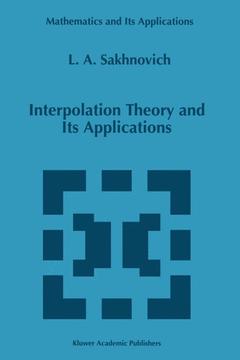Description
Interpolation Theory and Its Applications, Softcover reprint of the original 1st ed. 1997
Mathematics and Its Applications Series, Vol. 428
Author: Sakhnovich Lev A.
Language: English
Keywords
Finite; Identity; difference equation; equation; extrema; fourier analysis; function; mathematics; measure; variable
Publication date: 09-2011
197 p. · 16x24 cm · Paperback
197 p. · 16x24 cm · Paperback
Description
/li>Contents
/li>Comment
/li>
1. Interpolation problems play an important role both in theoretical and applied investigations. This explains the great number of works dedicated to classical and new interpolation problems ([1)-[5], [8), [13)-[16], [26)-[30], [57]). In this book we use a method of operator identities for investigating interpo lation problems. Following the method of operator identities we formulate a general interpolation problem containing the classical interpolation problems (Nevanlinna Pick, Caratheodory, Schur, Humburger, Krein) as particular cases. We write down the abstract form of the Potapov inequality. By solving this inequality we give the description of the set of solutions of the general interpolation problem in the terms of the linear-fractional transformation. Then we apply the obtained general results to a number of classical and new interpolation problems. Some chapters of the book are dedicated to the application of the interpola tion theory results to several other problems (the extension problem, generalized stationary processes, spectral theory, nonlinear integrable equations, functions with operator arguments). 2. Now we shall proceed to a more detailed description of the book contents.
1.Operator Identities and Interpolation Problems.- 1.1. Operator identities and statement of the problem.- 1.2. A matrix inequality.- 1.3. A transformed inequality.- 1.4. The solution of non-degenerate interpolation problems.- 1.5. The Weyl discs.- 1.6. Degenerate problems, a regularization method.- 1.7. Examples.- 2. Interpolation Problems in the Unit Circle.- 2.1. Operator identities and statement of the problem.- 2.2. Abstract matrix inequality.- 2.3. A transformed inequality.- 2.4. The solution of non-degenerate interpolation problems.- 2.5. Examples.- 3. Hermitian-Positive Functions of Several Variables.- 3.1. Auxiliary section.- 3.2. Non-extendible Hermitian-positive functions of two variables (discrete case).- 3.3. Non-extendible Hermitian-positive functions of three variables (discrete case).- 3.4. Continuous variant of extension problem.- 3.5. Concrete examples instead of existence theorems.- 3.6. Non-negative polynomials which cannot be represented in the form of the squares sum.- 4. De Branges Spaces of Entire Functions.- 4.1. De Branges spaces.- 4.2. De Branges matrices.- 4.3. The Parseval Equality.- 4.4. A functional model.- 4.5. On the linear equivalence of operators.- 4.6. The Parseval equality (continuation).- 5. Degenerate Problems (Matrix Case).- 5.1. Canonical representations.- 5.2. Solution of matrix inequality.- 5.3. Degenerate problems in the unit circle.- 6. Concrete Interpolation Problems.- 6.1. Tangential problem.- 6.2. Interpolation problems for the class of bounded functions.- 6.3. Schur problem.- 6.4. The Nevanlinna-Pick problem in the circle.- 6.5. Generalized stationary processes.- 7. Extremal Problems.- 7.1. Extremal Interpolation Problem.- 7.2. Schur extremal problem.- 7.3. Nevanlinna-Pick extremal problem.- 7.4. Maximal jump problem.- 8.Spectral Problems for Canonical Systems of Difference Equations.- 8.1. Direct and Inverse Spectral Problems on the Half-axis.- 8.2. The connection of the canonical systems with the classical systems.- 8.3. Livsic-Brodskii nodes and spectral theory.- 8.4. Spectral problems on the axis.- 8.5. Weyl-Titchmarsh matrix functions.- 8.6. The inverse spectral problem on the axis.- 9. Integrable Nonlinear Equations (Discrete Case).- 9.1. Evolution law of spectral data.- 9.2. Construction of hierarchy.- 10. On Semi-Infinite Toda Chain.- 10.1. Inverse problem and evolution of spectral data.- 10.2. Semi-infinite chain with a free end.- 10.3. The evolution law for the Toda chain with a fixed end.- 10.4. Analytical properties of the Weyl-Titchmarsh function.- 10.5. A half-finite chain with a fixed end, the solving procedure.- 10.6. Finite chain, solution procedure.- 11. Functions with an Operator Argument.- 11.1. Nevanlinna class functions with an operator argument.- 11.2. Positive functions with an operator argument.- 11.3. On Sarason scheme.- 11.4. Factorization formula.- Commentaries and Remarks.
This volume is devoted to the use of the method of operator identities for investigating interpolation and expansion problems. A general interpolation problem comprising both classical and new elements is formulated. The solution of an abstract form of the Potapov inequality enables the description of the set of solutions of the general interpolation problem. Connections between the solved interpolation problem and important problems of analysis, occurring in, for example, spectral theory, nonlinear integrable equations, and generalised stationary processes are then considered. Audience: This book will be of interest to graduate students and researchers whose work involves approximations and expansions, operator theory, measure and integration, general mathematics systems, and Fourier ana
© 2024 LAVOISIER S.A.S.
These books may interest you

Topics in Interpolation Theory 52.74 €



